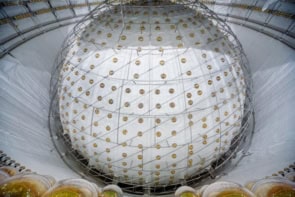The most accurate measurements yet of the imbalance between matter and anti-matter have been unveiled by the BaBar and Belle experiments. The new values of ‘sine 2β’ announced at the International Conference on High-Energy Physics in Amsterdam confirm the predictions of the Standard Model of particle physics, but still cannot fully account for the observed excess of matter in the Universe.
Cosmologists believe that equal amounts of matter and anti-matter were created in the big bang. If matter and anti-matter particles were exact opposites of each other, they should have annihilated to leave only photons. But the existence of our matter-dominated Universe suggests that matter and anti-matter underwent different processes. To account for this excess of matter, the Standard Model of particle physics predicts that matter and anti-matter decay at slightly different rates. Known as charge-parity (CP) violation, this effect was first seen in kaons in 1964.
Last year, the BaBar collaboration based at Stanford Linear Accelerator Centre in the US and the Belle collaboration based at the KEK laboratory in Japan spotted CP violation in another family of particles – B mesons – for the first time. Dubbed ‘B factories’ because of the huge numbers of B mesons and anti-B mesons they produce, both experiments showed that B mesons decay slightly slower than their anti-particles.
Now the BaBar collaboration has calculated that the parameter associated with CP violation –‘sine 2β’ – is 0.74±0.07, compared with its earlier estimate of 0.99±0.14. The increased accuracy stems from the larger number of decay events observed this time – 88 million in total. The BELLE collaboration puts the value of sine 2β – which they call sine 2φ1 – at 0.79±0.10.
Although the new estimates establish beyond doubt that CP violation exists, the researchers say that they do not appear to fully explain the observed imbalance between matter and anti-matter. Both teams now hope that ongoing experiments will reveal more subtle effects that will enable them to pin down the value of sine 2β.



